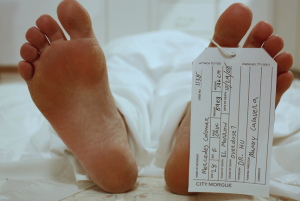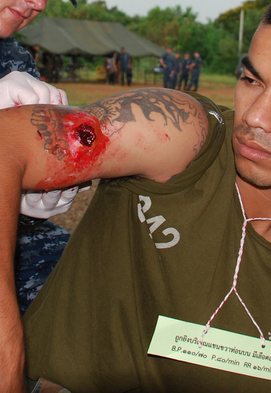Forensic Pathology
During a complete autopsy, all body cavities are examined. A limited autopsy examines most of the body though may exclude the head. Selective autopsies focus on specific areas or organs depending on the nature of death. The autopsy begins with a Y-shaped incision from both shoulders, joining over the sternum, and continuing down to the pubic bone. As the skin and underlying tissues are moved aside, the front of the rib cage is removed to expose the organs. Each of these are removed and examined as necessary. An incision is made in the back of the skull from ear to ear, and the skin peeled back. The top of the skull is removed using a vibrating saw, allowing the entire brain to be removed. The pathologist will aim to ascertain the manner of death, whether it be homicidal, suicidal, accidental, natural, or undetermined. Homicidal and suicidal deaths will typically then lead to further enquiry.
Marks of Violence
Asphyxiation
Asphyxiation is the inability to breathe and so lack of oxygen due to some obstruction of the respiratory system. Strangulation, smothering, and drowning are all common examples of this. Asphyxiation will bring about certain noticeable effects, including low levels of oxygen and high levels of carbon dioxide, and blood-staining around the mouth and nose. The skin may take on a purplish colour, a condition known as cyanosis. Tiny spots of haemorrhaging called petechiae may form due to the bursting of small blood vessels. Asphyxiation may cause the victim to vomit, which will collect in the mouth and throat. Strangulation may result in telltale marks left on the neck of the victim, whether bruising from hands or ligature marks. A smothered victim may be found with fibres in their mouth and throat. Victims of strangulation may also bear a broken hyoid bone, a horseshoe-shaped bone situated in the neck. Drowning, another common form of asphyxia, can be determined by water in the air passage and lungs. Further aiding the investigation, the water inside victims of drowning may be traced back to particular bodies of water based on the debris and diatoms (microscopic algae) found in them. Some forms of asphyxia may occur unintentionally, such as choking on food and accidental drowning.
Blunt Force Trauma
Caused by a blow to the body issued by some kind of blunt weapon, blunt force trauma is a commonly seen injury in many violent crimes. The outcome of the strike is dependent on the weight of the object used and the force behind it, as well as individual differences in the victim. A blow aimed at the head can result in damage to the skull, brain damage, and haemorrhaging.
Gunshot Wounds
All gunshot wounds can be divided into four types:
Contact: A shot in which the muzzle of the gun was applied to the skin and fired.
Close-Range: The muzzle of the gun was 6-8 inches away from the skin.
Intermediate Range: The gun muzzle was 8 inches to 3.5 feet away from the skin.
Distant: The gun was over 3.5 feet away from the skin.
The appearance and behaviour of a gunshot wound is greatly dependent on the type of ammunition and firearm used, as well as the circumstances of the shooting. Generally the exit wound is much larger and more ragged than the entry wound, with the exception of when the bullet is passing through flesh. Evidence of gunshot residues on the body can suggest the distance from which the projectile was fired. If the muzzle of the gun was held to the skin when fired, there will be soot residues and minute burns from the gunpowder. Firearms released within a certain distance of the skin will at least deposit some gunshot residues, which can later be detected. The entry wound itself can also yield information on the shooting. A close-range shot will often produce a splintered or star-shaped entry, whereas shots fired from further away will be neater. Examination of the wound may even allow for the angle of the bullet’s path to be determined.
Fatal shootings will often spark debate over whether the incident was suicidal or homicidal. If the gun was fired at a distance greater than arm’s length or from particular angles, suicide is almost always ruled out. The location of an entry wound is also important, as suicide victims rarely shoot themselves in, for example, the torso, instead opting for the head more frequently.
Stab Wounds
Though commonly associated with knives and blades, blunter objects have also been used in stabbings. By studying the wound itself, it may be possible to determine the instrument used to inflict the injury and establish whether the particular attack was fatal. A neat wound indicates the use of a sharp object, such as a knife, whereas ragged wounds would suggest a blunter instrument was used.
Though suicide by stabbing is fairly infrequent, cutting of the wrists and throat are one of the more common methods of suicide. The direction of the cut can be examined to determine whether they were made by the victim or could have been caused by someone else. Some suicide victims may bear hesitation scars and cuts on their wrists.
Time Since Death
As the temperature of the body drops at a fairly consistent rate after death, if affecting conditions are known, it may be possible to establish an estimated time of death. The average core living body temperature is 37⁰C or 98.6⁰F. At room temperature, the temperature of the body will drop about 1.5⁰C in the first hour after death, and between 1.5 and 1⁰C each hour after that. The core body temperature of the deceased will often be taken as soon as possible at the scene, either using a rectal thermometer or a reading from the liver. The study of body temperature is typically only relevant within a certain time frame, generally until the body temperature matches that of the environment.
A number of factors that affect the rate at which body temperature drops must be taken into account. A naked body will lose heat faster than a clothed body, just as a body of lesser weight will lose heat faster. The environment in general will affect the rate of heat loss substantially. A body submerged in water will lose temperature at a faster rate than a body in the desert, therefore it is imperative that the investigator makes note of the temperature and general conditions of a crime scene.
Decomposition
Decomposition is the continual process by which the tissues of a dead organism break down into simpler substances. As with body temperature, the environment will also affect the rate of decomposition. A cadaver will decompose at a much faster rate in damp conditions, whereas dry surroundings will slow down the rate. More can be read about this on the decomposition page.
Rigor Mortis
Approximately twelve hours after death a stiffening of the muscles occurs, caused by a loss of ATP and the accumulation of certain salts in the muscle fibre. ATP (adenosine triphosphate) allows energy to flow to the muscles, in this case to control calcium pumps inside the membrane of the muscle cells. This leads to a build-up of calcium ions, ultimately leading to muscle contractions and stiffness. The stiffness will naturally cease when the calcium ions have been expelled. Though rigor mortis lasts for around twelve hours, it can be mechanically ‘broken’ by moving the rigid muscles by force. The presence and state of rigor mortis can on occasion be used to determine time since death.
Livor Mortis
Also known as hypostasis, this occurs when the blood stops circulating the body and falls to its lowest point, resulting in a reddish-blue discolouration of the skin. Livor mortis develops fairly quickly, around one and a half to two hours after death. If a cadaver is moved to a different location or position after this time, the discolouration can act as a telltale sign of the movement.


